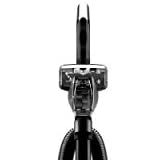This technology could save in the UK alone, 1.5 TWh of Electricity (Worth £150 Million annually), and is Equal to 645000 Tons of CO2 emissions.Air Recycling Technology Explained. There are two ways to remove dust and debris from the floor. 1 /. The vacuum cleaner that sucks air from the floor and passes it through a dust separator. It then returns the air stream back into the room wasting energy. 2/. The so called garden vac that in spite of its name does not use a vacuum to do the work but blows air onto the ground. The air stream is then diverted back up a duct carrying anything that gets into its path into a collecting bag. The air stream is then released into the surrounding air again wasting energy. However Air Recycling Technology uses both of the above techniques simultaneously by using the air stream to both blow and suck the dirt into a dust separator. For this reason it does not release air back into the room to waste energy. Prototype air recycling cleaners have been constructed that will out perform a 1400. watt vacuum cleaner when using only 250 watts. Tests were made in 2005 on behalf of the DTI Market Transformation Program that endorse these claims. The recent Ecovacuum project conducted in Brussels has suggested new targets in energy saving that cleaner manufacturers will be expected to meet. The solution to this would be for the manufacturers to employ air recycling technology in the manufacture of their cleaners. Air Recycling Technology can make a 250 …




is that vacuum in the video a modified panasonic?
whatever you call it, you’re still recycling the air and returning it to the room. I don’t see what you mean about wasting energy
Hi
Only a small amount of air is used and by continually recirculating it inside the cleaner no air is blown back into the room. But a Vacuum cleaner uses all the air in the room many times over.
The web pages will explain how this cleaner can do the same amount of work as a 1,400 watt vacuum cleaner using only 250 watt hour. A saving of over 80% of electricity.
Government tests have been conducted to back up these claims. Thanks for your interest.
Interesting video
Its an interesting concept. What exactly are you doing with the technology ? Have you raised a patent/pending ? What are the big vacuum cleaner boys doing or thinking about this technology ?
Seems promising. I just bought a Miele. Perhaps when it dies in the projected 10-20 years I will buy something like this 😉
This does seem like it would completely eliminate the need for hepa-like filtration. But I’m sure the big boys don’t want you saving money on those filters.
Be careful and good luck
@arcart0 looks very dubious.
Why would reusing the same air use less electricity than simply letting a motor suck in air from the room? Using the same air sounds less efficient.